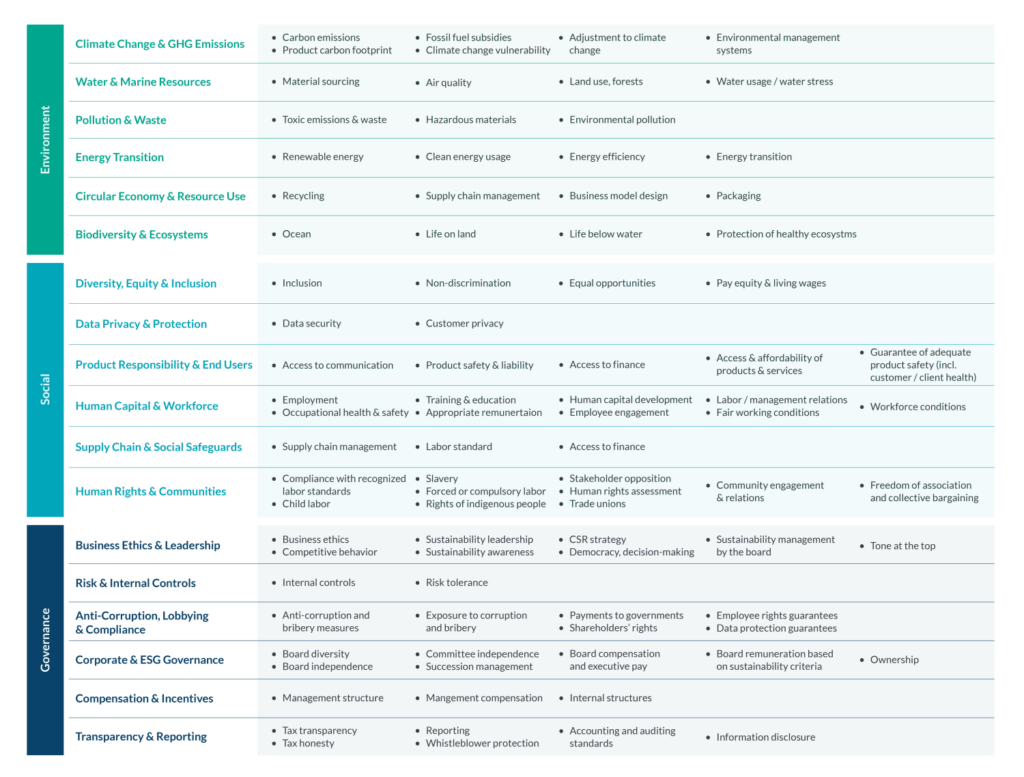ESG, or Environmental, Social, and Governance, is indeed a relatively new concept for many companies. At GreenedPoint, we take our responsibility to assist you in understanding different ESG standards, requirements, and market practices around the world very seriously. We believe that knowledge is the foundation for progress, and we are committed to helping businesses expand their understanding of sustainability.


What is ESG?
ESG, which stands for “Environmental, Social, and Governance,” originated from the 2006 United Nations’ Principles for Responsible Investment report and has gained significant traction over the years. It serves as a framework of reporting criteria utilised by the investment community to assess the sustainability and impact of a company’s activities. Through these criteria, investors aim to direct capital towards organisations that demonstrate responsible environmental practices (E), exhibit strong corporate citizenship towards their employees and communities (S), and are led by management teams capable of fostering positive change (G). Below are examples of ESG topics.

How do you choose what ESG topics to report on?
Choosing ESG topics to report on involves a thoughtful and systematic approach. Here are some steps to guide you in the process:
- Understand Stakeholder Expectations: Identify your key stakeholders, such as investors, customers, employees, regulators, and community members. Research and engage with them to understand their ESG priorities, concerns, and reporting expectations. This will help you align your reporting with their interests and ensure the relevance of your ESG disclosures.
- Conduct Materiality Assessment: Perform a materiality assessment to identify the ESG topics that are most relevant and impactful to your organisation and its stakeholders. Consider both internal and external factors, such as industry-specific risks, regulatory requirements, stakeholder concerns, and your organisation’s operations, values, and business strategy. This assessment will help you prioritise and focus on the most significant ESG topics for reporting.
- Reference Reporting Standards and Guidelines: Refer to recognized reporting standards and guidelines, such as the Global Reporting Initiative (GRI), Sustainability Accounting Standards Board (SASB), and Task Force on Climate-related Financial Disclosures (TCFD). These frameworks provide guidance on ESG topics and indicators specific to various industries. They can help you identify relevant ESG disclosure areas and ensure your reporting aligns with widely accepted principles and best practices.
- Consider Industry-Specific Factors: Take into account industry-specific ESG considerations. Different industries have distinct ESG risks, impacts, and stakeholder expectations. Understand the unique environmental, social, and governance challenges and opportunities within your industry. Consider topics such as carbon emissions for energy companies, labour practices for manufacturing firms, or product safety for consumer goods companies.
- Engage Internal Stakeholders: Involve key internal stakeholders, including executives, sustainability teams, risk management, compliance, and other relevant departments. Collaborate to identify and prioritise ESG topics based on their expertise, knowledge, and understanding of the organisation’s operations. Ensure cross-functional alignment and buy-in for the chosen topics.
- Set Goals and Targets: Establish measurable goals and targets related to the selected ESG topics. This will enable you to track progress, demonstrate improvement over time, and provide a basis for future reporting and performance evaluation.
- Continual Evaluation and Feedback: Regularly review and reassess your ESG reporting topics to ensure ongoing relevance and alignment with stakeholder expectations. Seek feedback from stakeholders, monitor emerging ESG trends, and adapt your reporting strategy accordingly.
Remember, ESG reporting is an iterative process. It’s important to continuously evaluate and refine your approach based on stakeholder feedback, evolving industry standards, and emerging sustainability issues.
What ESG reporting standards are there?
There are several ESG reporting standards and frameworks available for organisations to use when disclosing their sustainability performance. Here are some of the most widely recognized and commonly used ESG reporting standards:
- Global Reporting Initiative (GRI): GRI provides a comprehensive framework for sustainability reporting, covering a wide range of economic, environmental, and social aspects. It offers guidelines and indicators that organisations can use to report their ESG performance.
- Sustainability Accounting Standards Board (SASB): SASB focuses on industry-specific sustainability reporting standards. It provides guidelines for disclosing financially material ESG topics relevant to specific industries, helping companies identify and report on the most significant ESG issues based on their sector.
- Task Force on Climate-related Financial Disclosures (TCFD): TCFD offers recommendations for disclosing climate-related risks and opportunities. It provides a framework that helps organisations assess and disclose climate-related information in their financial filings and mainstream climate-related considerations in their decision-making processes.
- Carbon Disclosure Project (CDP): CDP is an organisation that encourages companies to disclose their environmental impacts, particularly related to carbon emissions, climate change, water usage, and deforestation. It provides a platform through which organisations can report their ESG data and benchmark their performance against peers.
- United Nations Sustainable Development Goals (SDGs): The SDGs are a set of 17 goals established by the United Nations to address global social, economic, and environmental challenges. Organisations often align their sustainability reporting with the SDGs to demonstrate how their activities contribute to the achievement of these goals.
- Integrated Reporting Framework (IR Framework): The IR Framework promotes integrated reporting, which aims to provide a holistic view of an organisation’s value creation over time. It encourages companies to report on their financial performance as well as their ESG impacts and dependencies.
It’s important to note that organisations can choose to adopt one or multiple reporting standards based on their specific needs and industry requirements. Many companies also consider relevant regional or national reporting guidelines and regulations when preparing their ESG reports.

What data is needed for ESG reporting?

How to get the data for ESG reporting?
Collecting data for ESG reporting requires a systematic approach and access to relevant information. Here are some steps to help you gather data for ESG reporting:
- Define Key Performance Indicators (KPIs): Identify the specific ESG metrics and indicators that align with your chosen ESG topics and reporting frameworks (e.g., GRI, SASB, TCFD). These KPIs will serve as a basis for data collection and measurement.
- Internal Data Collection: Start by gathering data from your organisation’s internal sources. This may include financial reports, operational data, HR records, energy consumption data, waste management records, employee surveys, diversity and inclusion metrics, health and safety data, and other relevant internal systems. Engage relevant departments or teams within your organisation to provide the necessary data.
- Transforming data collected to KPIs: Some data requires processing, for example, to calculate emission, a emission factor needs to be obtained. Emission factors represent the amount of CO2e emissions associated with a specific energy source. These factors are typically expressed as kilograms (or pounds) of CO2e emitted per unit of energy consumed (e.g., kWh, therms, gallons, etc.). Emission factors can be obtained from various sources, such as government agencies, industry associations, or sustainability databases.
Remember to maintain data integrity, adhere to privacy regulations, and ensure that sensitive or confidential information is adequately protected throughout the data collection and reporting process.
How does a supplier ESG questionnaire impact the business relationship with your client?
Supplier ESG questionnaires can have a significant impact on the business relationship with your client in several ways:
- Transparency and Trust: By responding to a supplier ESG questionnaire, you demonstrate a commitment to transparency and openness about your organisation’s ESG practices. This can help build trust with your client, as they gain insight into your sustainability efforts and performance.
- Alignment of Values: ESG questionnaires often inquire about various sustainability aspects, such as environmental impact, labour practices, and supply chain ethics. If your responses align with your client’s values and ESG priorities, it can strengthen the alignment between your organisations and foster a shared commitment to sustainability.
- Risk Mitigation: ESG questionnaires enable your client to assess the potential risks associated with your business operations, such as environmental liabilities, regulatory compliance, or reputational risks. By providing comprehensive and accurate responses, you demonstrate your proactive approach to risk management, which can enhance your client’s confidence in your ability to mitigate ESG-related risks.
- Competitive Advantage: Depending on the industry and market, having strong ESG credentials can provide a competitive advantage. Responding to supplier ESG questionnaires and showcasing your robust sustainability practices may position your organisation favourably compared to competitors who do not prioritise ESG considerations. This can strengthen your business relationship with your client, as they see you as a preferred supplier aligned with their sustainability goals.
- Collaboration and Improvement Opportunities: Supplier ESG questionnaires often include inquiries about improvement areas and future targets. Engaging in dialogue with your client regarding ESG performance can create opportunities for collaboration, knowledge sharing, and joint efforts to advance sustainable practices. This collaborative approach can deepen the business relationship and lead to mutually beneficial outcomes.
- Compliance Requirements: In some cases, responding to supplier ESG questionnaires may be necessary to meet specific compliance requirements or qualify for certain contracts. Failing to provide satisfactory ESG responses may hinder your ability to secure or maintain the business relationship with your client.
Overall, supplier ESG questionnaires have the potential to impact the business relationship with your client by fostering transparency, trust, alignment of values, risk mitigation, competitive advantage, collaboration, and compliance. By demonstrating your commitment to sustainable practices and effectively addressing ESG concerns, you can strengthen the partnership and contribute to long-term business success.
What are some important ESG ratings?
There are several ESG rating agencies and organisations that provide ESG ratings and assessments for companies. Here are some prominent examples:
- EcoVadis Supplier ESG Rating: The EcoVadis Supplier Rating is based on a comprehensive assessment that considers documentation, policies, and practices related to sustainability. The assessment covers a range of topics such as environmental impact, labour and human rights, fair business practices, and sustainable procurement. EcoVadis uses a standardised methodology and scoring system to evaluate suppliers consistently and compare their performance against industry peers.
- MSCI ESG Ratings: MSCI is a leading provider of ESG ratings and research. Their ESG Ratings evaluate companies’ exposure to and management of ESG risks and opportunities. MSCI assigns ratings ranging from AAA (highest) to CCC (lowest) based on a company’s ESG performance relative to industry peers.
- Sustainalytics: Sustainalytics offers ESG ratings and research on thousands of companies globally. Their ratings assess companies’ performance across multiple ESG dimensions and assign a numerical score. The scores are then mapped onto a five-point scale, ranging from 1 (lowest) to 5 (highest), indicating a company’s ESG risk exposure.
- CDP (formerly Carbon Disclosure Project): CDP focuses primarily on environmental aspects, particularly carbon emissions, climate change, water usage, and deforestation. They provide companies with scores based on their environmental disclosures and performance.
It’s important to note that each rating agency or organisation has its own methodology, criteria, and scoring system. ESG ratings can vary between providers due to differences in data sources, weighting of ESG factors, sector-specific considerations, and other factors. Companies may consider multiple ESG ratings and assessments to gain a comprehensive understanding of their ESG performance and to meet the requirements of different stakeholders.
